Stories
Ann Lynch
1943-
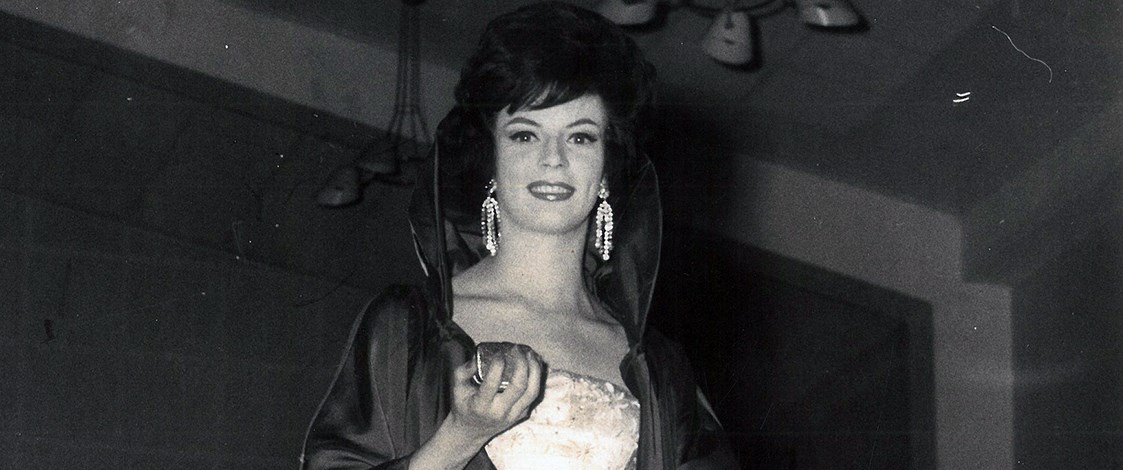
She was once described as "a star in any model constellation" but Ann Lynch did not set out to be a fashion model. Like many of her contemporaries Ann attended classes at Berin Spiro’s Charm School in downtown Auckland while still a student at St Mary’s College. In the late 1950s and early 1960s charm school was where adolescent girls went to acquire poise and personality by learning such things as deportment, grooming and etiquette.
This was also the era when 'coming out' meant making your debut as a young woman into adult society. Dressed in virginal white gowns and elbow-length white gloves, debutantes were presented at a charity ball, in Ann’s case to the Catholic Archbishop Liston of Auckland. Included among the many St Mary’s 'debs' that year was a girl named Kiri te Kanawa. Ann’s ruched debutante dress was designed and made by a very young Kevin Berkahn. Their paths were to cross many times in the future.
Ann Lynch as a teenager in the late 1950s. Images © Ann Simich (nee Lynch).
'Finishing' young ladies was a competitive business. In 1960, Peggie Wilson, a designer, dressmaker and former modelling school tutor from Melbourne, opened her Academy of Elegance not far from Spiro’s. And it was at the Academy in 1961 that Ann got her first job as secretary receptionist after completing a business course. However one of the perks of her job was being allowed to sit in on the modelling classes.
"As well as learning about makeup and deportment, we learned such things as how to put on a coat while you were walking; how to take it off; how to carry a handbag with the right wrist position; how to wear a long gown in comparison to streetwear or swimwear; how to pause at the end of a catwalk and how to do quarter, half and full turns," Ann recalls.
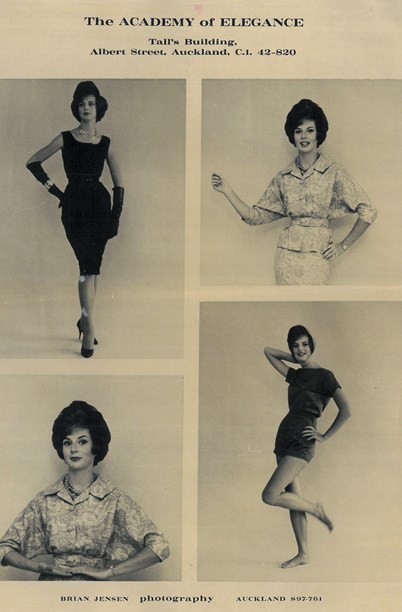
Photos from Ann's time at the Academy of Elegance. Image courtesy of Ann Simich (nee Lynch).
Tall, skinny with dark blue eyes and hair that would be dyed to a deep brunette, Ann caught the eye of New Zealand Gown of the Year fashion promoter, Tam Cochrane. Auditions were competitive but Ann was one of three Academy girls chosen to model for the third Gown of the Year extravaganza in 1961. Along with another four models she was swept up in what at the time, was New Zealand’s most prestigious and glamorous annual fashion event. "I was 17 at the time and Tam had to come and see my parents to get permission for me to be in it," she says.
In her book The New Zealand Gown of the Year Claire Regnault writes: "For the girls chosen, the New Zealand Gown of the Year represented a modelling plum. From the moment they joined the 'Fashion on Wheels' caravanserai the models appeared in the country’s papers almost on a daily basis. It was their names and faces, rather than those of the designers, that became associated with the spectacular gowns they wore."
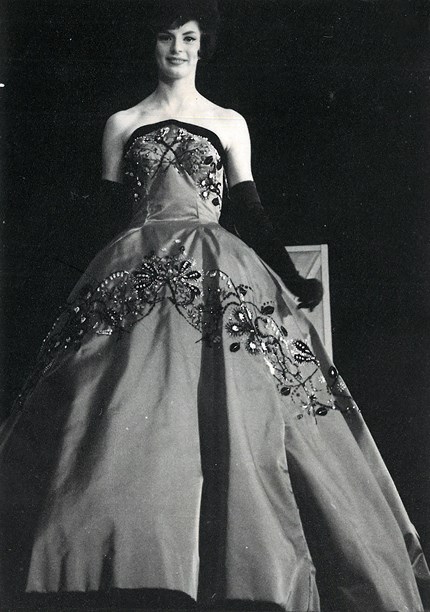
Ann modelling the gown 'Tosca' at the 1962 Gown of the Year awards. Image courtesy of Ann Simich (nee Lynch).
The Academy of Elegance graduation brochure of 1961 says of its star pupil (another star that year was a future Miss New Zealand, Leonie Main), that: "Since joining the Academy staff Ann has done parades, TV and commercial work. She is one of three New Zealand girls seen in Vogue this year and is classified as one of Auckland’s top photographic models."
Ann was among a select few who were chosen to model for Tam three years in a row and she had the 'rare honour' of wearing the winning gowns twice. Ann herself remembers her time with Gown of the Year as the highlight of her comparatively brief modelling career. "I can remember my first pay cheque as a model. I think we were in Wanganui and I bought my parents an electric blanket which were a new luxury on the market."
Life on the road was fun but not at all glamourous. "There was no luxury. We didn’t have time to go to the hairdresser. Half the time we’d be travelling with rollers in our hair. We’d arrive in a town and Tam would have always arranged a photo shoot." Then it was on with the show, or in some centres several back-to-back shows. There was no such thing as a hairdresser or makeup artist backstage. "We had to do our own. We applied hair pieces which would be used as long ponytails, for the beachwear, taken off for streetwear then reapplied as top knot petals for the formal gown sections."
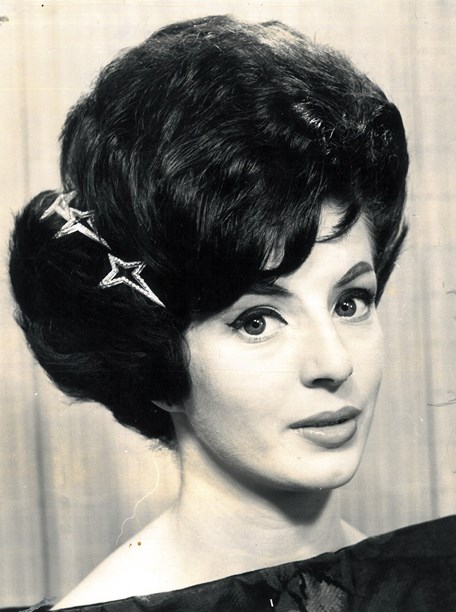
Ann Lynch, 1962. Image courtesy of Ann Simich (nee Lynch).
Although the models were like celebrities in the towns they visited, downtime was often quiet and as a strict chaperone, Tam insisted on a set bedtime and no drinking.
"We couldn’t go to the bar because you had to be 21. One time we did sneak down to a private bar in the hotel we were staying at. I remember someone saying 'Tam’s coming!' And I hid by lying crossways on the bench under the bar counter while she grilled the barman!"
Knitting was a favoured occupation while the girls were on the road. "We used to call our knitting group the 'Happiness Club'. We would sit and knit in our motels. One of the models Di Cooper (now Goldsworthy) and I are still best friends. She was also my bridesmaid."
Another lifelong connection was made with a handsome young detective who occasionally hung out at the back of the hall during the shows. One evening he plucked up the courage to politely ask Tam Cochrane if he could take Ann out to supper after the show. "I will ask Ann first. Stand at the front of the hall so she can take a good look at you," was Tam’s response. Ann obviously liked what she saw. She and Clem Simich (a future National MP for Tamaki and Minister of Police) would marry in 1965.
Ann spent the rest of her year as a freelance model. There were wholesale collections for buyers to be shown. She did parades at department stores such as John Courts and Milne & Choyce in Auckland, where Paddy Walker was making her mark as a fashion compere. "I did some shows for Paddy," Ann remembers, "but she didn’t really like my black hair. And I had to go black each year for the Gown of the Year; I was a dark blonde really but in those days it was hard to get rid of the black."
She was also in demand for photographic work for seasonal supplements in newspaper fashion and women’s pages. There are memories too of doing what she says was the very first television commercial. "It was in black and white, a still shot and it was an ad for jandals!"
Another memory is of the 'Twice as Nice' shampoo campaign. She still has a magazine shot published in the NZ Woman’s Weekly stowed away in a suitcase full of old press clippings and photographs. "That was a fun shoot. They had dry ice to create the steam and they’d made a swing with flowers woven all down the ropes. I was on the swing with all this steam rising up around me."

Ann modelling for a Twice as Nice shampoo ad, 1960s.
Over the next few years, when times were slow between fashion seasons, Ann had her shorthand typing to fall back on.
In the 1960s there were other big shows besides Gown of the Year. The Golden Shears was presented by the Professional Mannequins Association of New Zealand Inc. It was a gala fashion event that raised money for charities and also raised the profile of the growing modelling industry in this country.
For the 1962 Golden Shears, Peggie Wilson from the Academy of Elegance decided to display her design skills by making a gown especially for Ann to model. 'Venus’' was a white cloque sheath with a jacket that could also be worn as a cape.
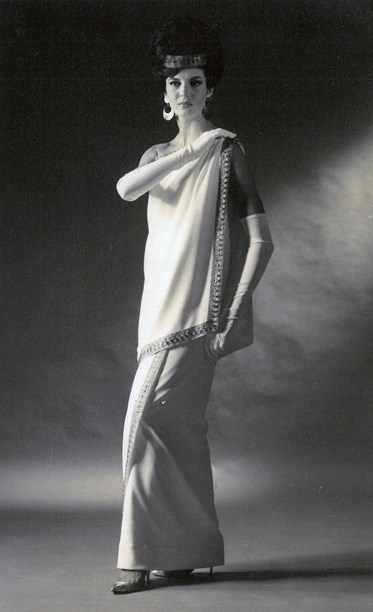
Ann Lynch modelling Peggie Wilson's gown, 'Venus' in 1962. Image © Peggie Wilson.
"I can still remember fittings for that gown," Ann says. "It only had one seam and the folds had to be exactly right. I stood for hours and we had so many fittings. But it was worth it. Out of a group of 19 gowns, it was Peggie’s that took the top honour."
That same year Ann was chosen by the Newspaper Proprietors’ Association as the 'Woman of Beauty' for a national advertising campaign.
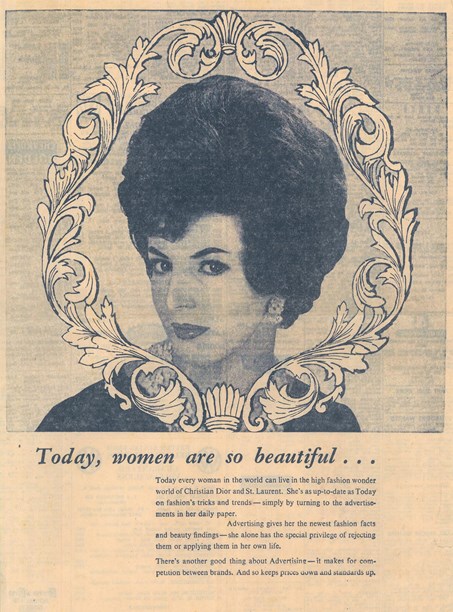
In 1962 Ann was selected as the 'Woman of Beauty' for a national advertising campaign.
By the mid-sixties the local fashion scene was changing. Gone was the emphasis on romantic gowns of the post-war era. The future focus was on youth and the fashion revolt of 'Swinging London' was reverberating in the Southern hemisphere. For Ann, who had the first of her three children in 1967, modelling became an occasional occupation. Her fashion knowledge and panache would come to light later in life as she took up a career in marketing and public relations, particularly in the beauty and health sector. Currently she runs a marketing agency with her son Ricardo.
Text by Katherine Findlay. Banner image courtesy of Ann Simich.
Published May 2019.